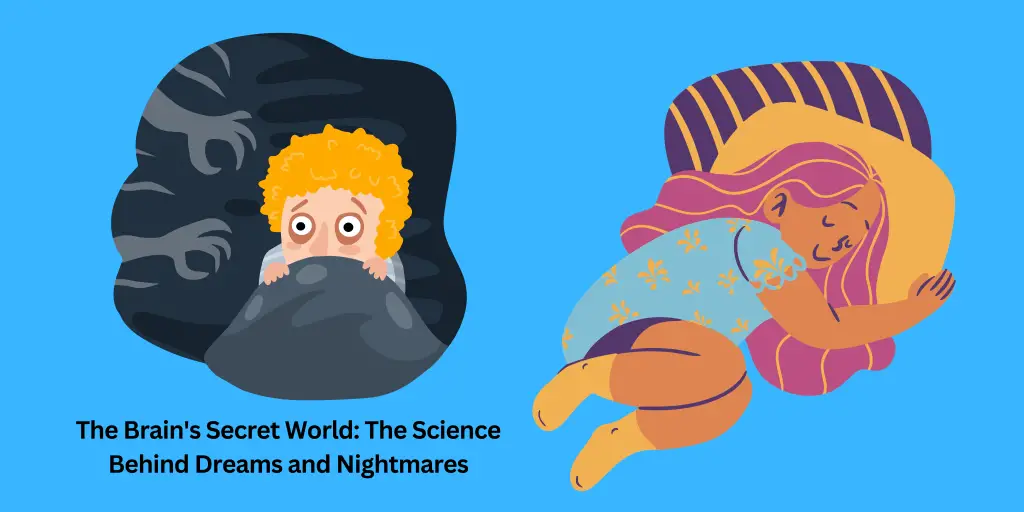
Have you ever wondered why we dream? Or why can some dreams be so vivid and intense, while others are more mundane? Dreams have been a source of fascination for centuries, with many cultures believing they contain hidden messages from the gods.
But what is the science behind them?
Dreams occur during REM (Rapid Eye Movement) sleep, usually around 90 minutes after falling asleep.
During this stage of sleep, your brain activity increases significantly and your eyes move rapidly under your eyelids. It’s thought that this increased brain activity helps to process memories and emotions from the day before – essentially helping us to make sense of things in our lives.
Scientists believe that dreams help us to work through difficult situations or unresolved issues in our lives by creating scenarios where we can explore different options without any real-world consequences.
This could explain why some people experience nightmares – as their subconscious mind tries to work through a particularly stressful situation or traumatic event in their life.
The content of dreams varies significantly between individuals; some may have recurring themes such as being chased or flying while others may feature more abstract images like colors and shapes with no clear meaning attached to them!
It’s believed that these types of dream images represent random firing neurons within the brain rather than having any specific message attached to them – although it’s still possible for people who experience these kinds of dreams regularly over time might eventually find meaning within them if they pay attention closely enough!
How does the brain express Our Nightly Adventures?
Dreams are thought to be our brain’s way of processing information from the day. During REM (rapid eye movement) sleep, neurons fire rapidly in different parts of your brain, creating images and stories that make up your dreamscape.
When we dream, our brains become more active and creative, allowing us to explore a world that we cannot experience during the day. Dreams allow us to process our emotions and practice different scenarios in a safe environment, free of the consequences of real life.
Dreams can range from pleasant fantasies to frightening nightmares; both help us process emotions and experiences from waking life.
Nightmares have been studied extensively by scientists who believe they may serve an evolutionary purpose – helping us prepare for potential threats or dangers in real-life situations.
Nightmares often involve themes such as being chased or attacked by someone or something; this could represent a fear response which helps us practice how we would react if faced with similar danger during wakefulness.
What is the link between Dreams and Nightmares?
Dreams and nightmares can be mysterious, fascinating, and sometimes even frightening.
Recent research suggests that dreaming plays an important role in our mental health. Dreams are thought to help process emotions, consolidate memories, and provide insight into our subconscious minds.
Nightmares may serve a purpose by alerting us to potential danger or helping us work through difficult life events.
The content of dreams varies greatly from person to person but they often involve themes such as :
- fear or anxiety;
- intense emotions;
- vivid imagery;
- bizarre settings;
- or strange characters like animals or monsters.
The same goes for nightmares – they often contain elements of fear but may also include feelings of helplessness or being chased by something unknown.
Although it’s still unclear exactly why we dream (or nightmares), scientists believe that certain factors such as:
- stress levels,
- medications are taken before bedtime
- sleep deprivation
- and diet choices during the day
Those could all play a role in influencing dream content and intensity level.
The connections between dreams and nightmares are usually related to the emotions we feel while awake. Dreams, both good and bad, can help us make sense of our lives and gain a better understanding of ourselves.
What Do Your Dreams or Nightmare Reveal About You?
Some research has shown that our dreams may reflect how we feel in real life. If you’re feeling stressed or anxious during the day, it’s possible your dream could contain elements of those feelings as well.
Similarly, if you’re feeling happy or content in your waking life then this could also be reflected in your dreamscape too.
Nightmares usually reveal your subconscious fears and anxieties more so than dreams. It’s possible that nightmares could indicate unresolved issues or worries we have during the day, but haven’t fully resolved.
Another interesting thing to consider is whether certain symbols appear frequently in our dreams such as:
- A particular animal or object
- what might represent us personally
- The environment you find yourself in or the people you meet
It’s thought that these symbols can act like metaphors for aspects of ourselves that we haven’t yet explored fully; so by paying attention to them we can gain insight into who we are on a deeper level.
Can We Control What We Dream About?
Dreams are a fascinating phenomenon, with some people believing they have prophetic powers while others simply see them as random thoughts or images created in our minds during sleep.
But regardless of how you view them, dreams can be incredibly powerful and meaningful experiences.
One way to potentially control your dreams is through lucid dreaming – this involves becoming aware of the fact that you’re dreaming while still asleep!
Doing so, allows us to take control of our own dream world and explore different scenarios without any real-life consequences. This could be anything from flying over landscapes or visiting distant planets – all within the safety of your own mind!
Another method involves setting intentions before bedtime; focusing on specific topics such as career goals or relationships before going to sleep, increases the likelihood that these will appear in your dream state later on in the night.
Additionally, keeping a journal next to your bed can help capture those fleeting moments when you wake up from a particularly vivid dream – writing down keywords or phrases associated with what happened might help trigger similar events again in future nights’ restful slumber!
Conclusion
The main reasons for normal dreams or nightmares are stress levels, medications taken before bedtime, sleep deprivation, and diet choices during the day. Dreams can help us make sense of our lives and gain a better understanding of ourselves.
Nightmares, more than dreams, tend to reveal our subconscious fears and anxieties.
Regardless of how you look at it, dreams can be extremely powerful and meaningful experiences that we can control in our daily lives. Keeping a journal nearby can help trigger similar events in future nights of restful slumber!








